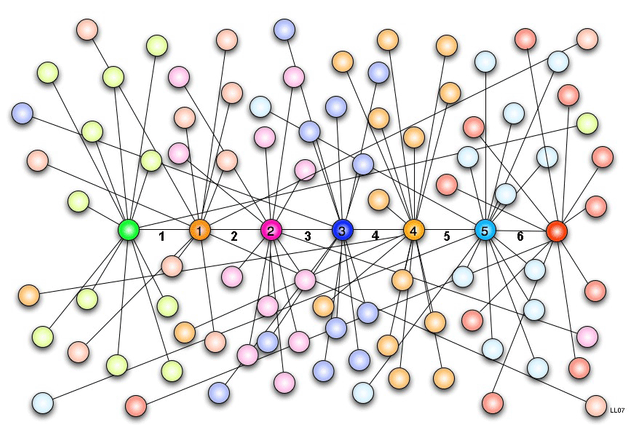Theory of the Six Degrees of Separation
Greetings community, I hope you are well, today I bring you an interesting postulate, which is known to be scientifically proven, mathematically and statistically, gives enough to talk about and is a rather interesting subject and at the same time is curious. I am talking about the "Theory of the Six Degrees of Separation"
Theory of the six degrees of separation
This theory pose that almost any individual of the Earth is related to any other one through a circle of acquaintances that does not surpass 6 in the chain. That is, in short, we are only 6 "people" to meet any other on the planet. This theory was first raised in the year 1929 by a Hungarian citizen, whose name was Frgyes Karinthy in one of his books whose title was "Chains". Approximately in the 1950s, two scientists (Ithiel de Sola Pool and Manfred Kochen) tried to prove this theory in a mathematical way, where they wanted to know what were the possibilities of people belonging to a group were could know each other. However, they spent more than 15 years and failed to achieve appropriate results. In the 1960s the psychologist Stanley Milgram did an experiment called "The Problem of the Small World" to test the theory, he randomly chose different American people living in the Western and Central region of USA, with the purpose of sending a package to an individual without knowing him, only knowing his name and a not very specific location (Only knowing that he lived in Massachusetts). Although the majority of participants doubted that the package could arrive in so few shipments the results proved otherwise, the average number of people by which the package passed was about 5 to 7.
In spite of the results obtained with the experiment, it was said that this was not very well justified because there were not many participants of the experiment, however, this experiment was the first that were made based on the six degrees of Separation, therefore motivated other people and institutions to carry out different studies, games and dynamics related to theory.
Nowadays, the internet has a lot more functions than a few years ago. This, together with social networks, not only makes the theory more credible, but also reduces the number of "links" necessary to get in touch with any individual you want, for example on Facebook the average separation between people is 4.74, and on Twitter that is 4.6. So ultimately, social networks have played a very important role when it comes to interacting with people from anywhere on the planet.
I want to thank you if you have come here, I hope you liked the content; you can leave me a vote if so. You can also leave me a comment with your opinion about the post content or give me a suggestion on how I could do better in the next ones :)
References:
- http://www.vix.com/es/btg/curiosidades/6376/que-dice-la-teoria-de-los-seis-grados-de-separacion (Spanish)
- https://en.wikipedia.org/wiki/Six_degrees_of_separation
- http://www.erroreshistoricos.com/curiosidades-historicas/888-la-teoria-de-los-seis-grados-de-separacion.html (Spanish)
- http://journal.webscience.org/147/2/websci09_submission_49.pdf


On Steemit Its probably like 3 degrees of separation lol
So true hahaha
This post has been ranked within the top 80 most undervalued posts in the first half of Jan 26. We estimate that this post is undervalued by $4.36 as compared to a scenario in which every voter had an equal say.
See the full rankings and details in The Daily Tribune: Jan 26 - Part I. You can also read about some of our methodology, data analysis and technical details in our initial post.
If you are the author and would prefer not to receive these comments, simply reply "Stop" to this comment.